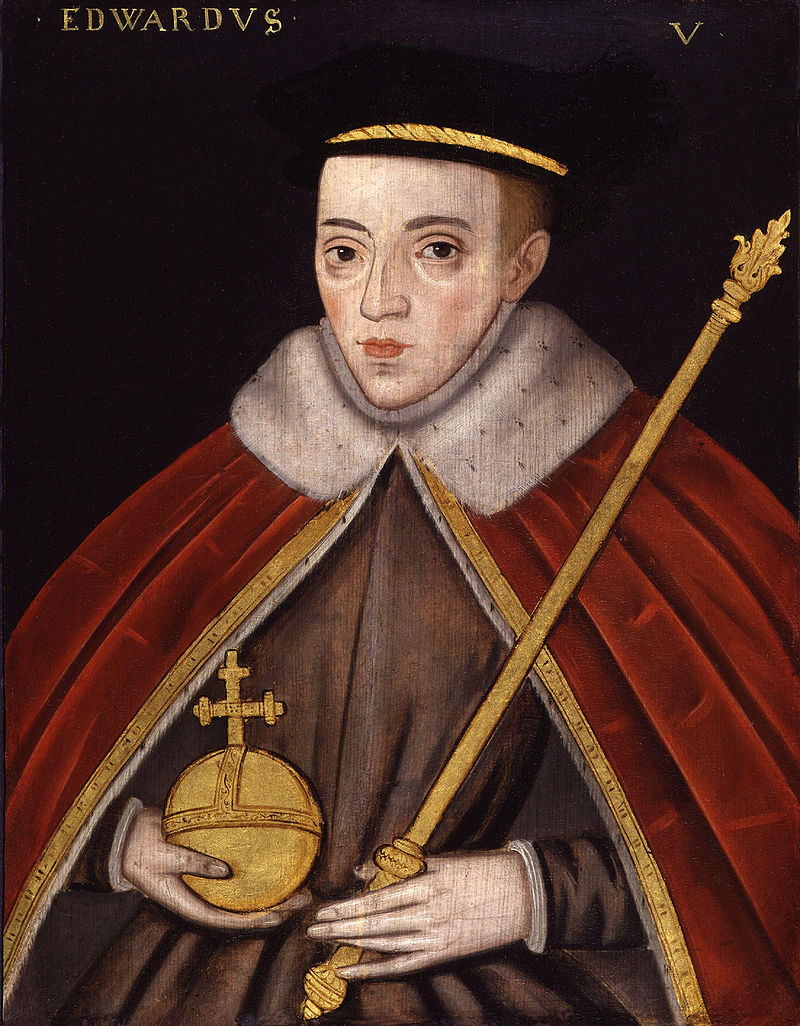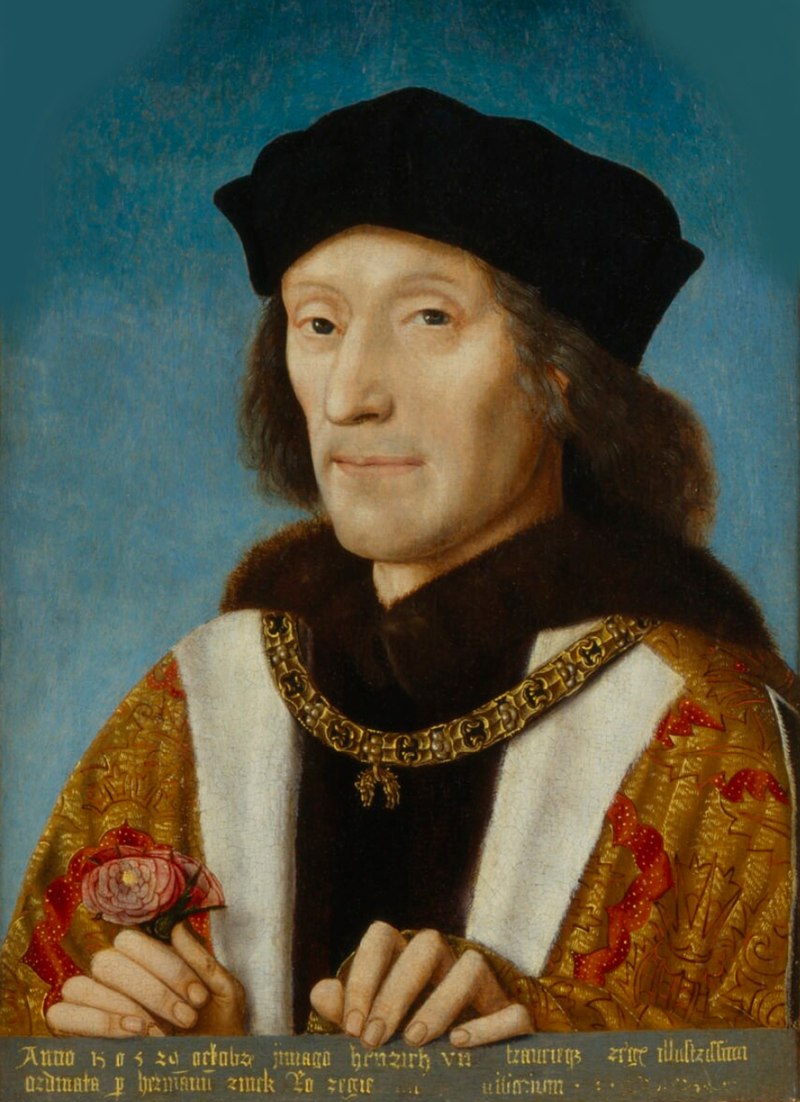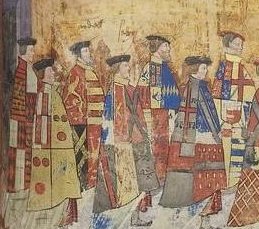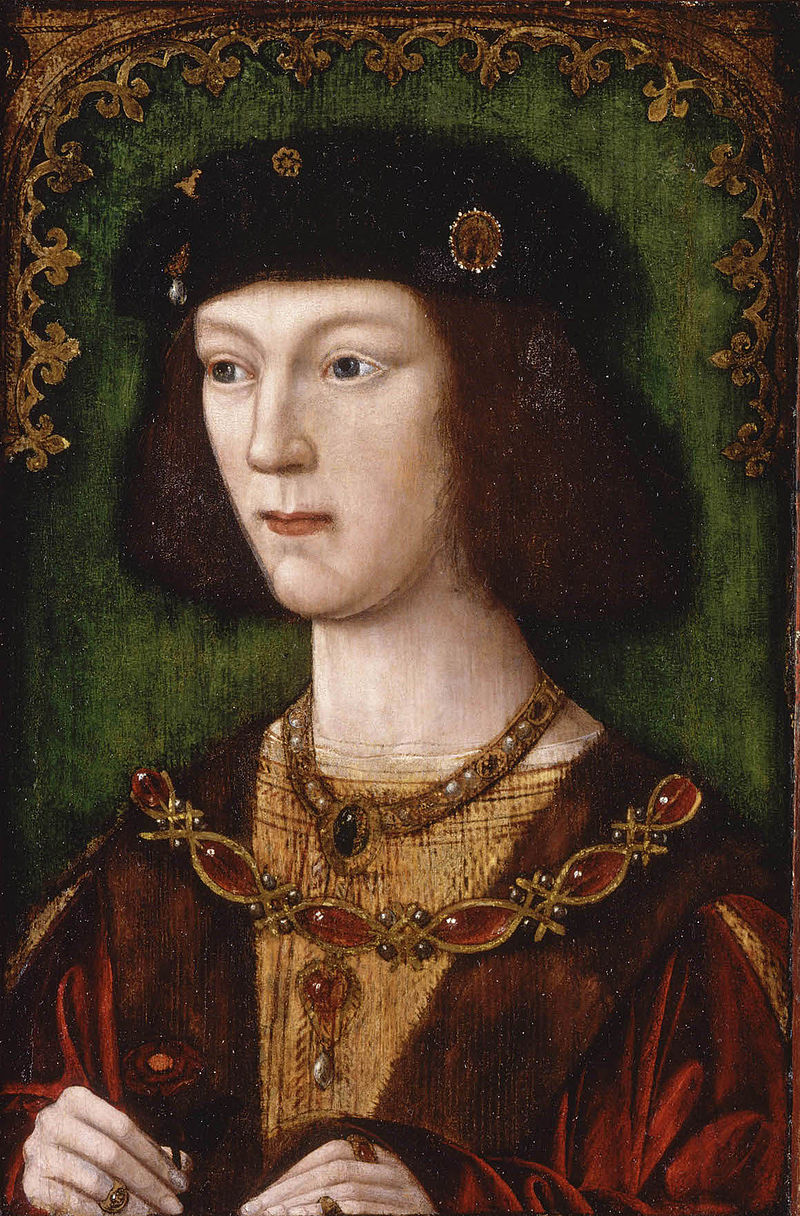by Susan Flantzer
© Unofficial Royalty 2023

The five eldest surviving daughters of King Edward IV, left to right: Elizabeth, Cecily, Anne, Catherine, and Mary. This stained glass window in Canterbury Cathedral was made by order of King Edward IV; Credit – Wikipedia
Born on August 14, 1479, at Eltham Palace in Greenwich, England, Catherine of York, Countess of Devon was the ninth of the ten children and the sixth of the seven daughters of King Edward IV of England, the first King of England from the House of York, and Elizabeth Woodville. Anne’s paternal grandparents were Richard of York, 3rd Duke of York and Cecily Neville, both great-grandchildren of King Edward III of England. Her maternal grandparents were Sir Richard Woodville, 1st Earl Rivers and Jacquetta of Luxembourg.

Catherine’s father King Edward IV of England; Credit – Wikipedia
Catherine’s father King Edward IV was the eldest surviving son of Richard of York, 3rd Duke of York who had a strong claim to the English throne. The social and financial troubles that followed the Hundred Years’ War, combined with the mental disability and weak rule of the Lancastrian King Henry VI had revived interest in the claim of Richard, 3rd Duke of York, and the Wars of the Roses were fought between supporters of two rival branches of the royal House of Plantagenet, the House of Lancaster and the House of York between 1455 and 1487. Richard, 3rd Duke of York was killed on December 30, 1460, at the Battle of Wakefield and his son Edward was then the leader of the House of York. After winning a decisive victory on March 2, 1461, at the Battle of Mortimer’s Cross, 19-year-old Edward proclaimed himself king. In 1464, King Edward IV married Elizabeth Woodville.
Catherine’s mother Elizabeth Woodville; Credit – Wikipedia
Catherine had nine siblings:
- Elizabeth of York (1466 – 1503), married King Henry VII of England, had seven children including King Henry VIII of England, Margaret Tudor, Queen of Scots, and Mary Tudor, Queen of France
- Mary of York (1467 – 1482), unmarried, died in her teens
- Cecily of York, Viscountess Welles (1469 – 1507), married (1) Ralph Scrope of Upsall, no children, marriage annulled (2) John Welles, 1st Viscount Welles, had two daughters who died young (3) Sir Thomas Kyme, possible children
- King Edward V of England (1470 – circa 1483), briefly succeeded his father, as King Edward V of England, was the elder of the Princes in the Tower
- Margaret of York (born and died 1472)
- Richard of Shrewsbury, 1st Duke of York (1473 – circa 1483), was the younger of the Princes in the Tower
- Anne of York, Lady Howard (1475 – circa 1511 – 1513), married Lord Thomas Howard, the future 3rd Duke of Norfolk, had four children but none survived childhood
- George Plantagenet, 1st Duke of Bedford (1477 – 1479), died in childhood probably from the bubonic plague
- Bridget of York (1480 – 1517), became a nun
Catherine had two half-brothers from her mother’s first marriage to Sir John Grey of Groby:
- Thomas Grey, 1st Marquess of Dorset (1455 – 1501), married (1) Anne Holland, no children; (2) Cecily Bonville, 7th Baroness Harington and 2nd Baroness Bonville, had 14 children; Thomas and Cecily are the great-grandparents of Lady Jane Grey
- Sir Richard Grey (1457 – 1483), unmarried, executed by Richard, Duke of Gloucester (future King Richard III)
Being the daughter of the King of England, Catherine was a desirable royal bride. A preliminary marriage agreement was arranged before she was even one month old. Catherine was to marry Juan of Aragon, Prince of Asturias, the eldest son and heir of Ferdinand II, King of Aragon, King of Castile and León and Isabella I, Queen of Castile and León. When Catherine’s father suddenly died, the marriage negotiations were terminated.

A late-16th/early 17th-century image of Catherine’s brother King Edward V of England, one of the missing Princes in the Tower; Credit – Wikipedia
When Catherine was not quite four-years-old, her father King Edward IV died on April 9, 1483, a few weeks before his 41st birthday. Anne’s twelve-year-old brother succeeded their father as King Edward V, and King Edward IV’s brother, Richard, Duke of Gloucester, was named Lord Protector of his young nephew and moved to keep the Woodvilles, the family of Edward IV’s widow Elizabeth Woodville, from exercising power. The widowed queen sought to gain political power for her family by appointing family members to key positions and rushing the coronation of her young son. The new king was accompanied to London by his maternal uncle Anthony Woodville, 2nd Earl Rivers and his half-brother Sir Richard Grey. Rivers and Grey were accused of planning to assassinate Richard, Duke of Gloucester, and were arrested, and taken to Pontefract Castle, where they were later executed without trial. Richard, Duke of Gloucester then proceeded with the new king to London where Edward V was presented to the Lord Mayor of London. For their safety, King Edward V and his nine-year-old brother Richard, Duke of York were sent to the Tower of London and were never seen again. They are the famous Princes in the Tower.
On June 22, 1483, a sermon was preached at St. Paul’s Cross in London declaring Edward IV’s marriage to Elizabeth Woodville invalid and his children illegitimate. This information came from Robert Stillington, Bishop of Bath and Wells, who claimed a legal pre-contract of marriage to Eleanor Butler, had invalidated King Edward IV’s later marriage to Elizabeth Woodville. The citizens of London presented Richard, Duke of Gloucester with a petition urging him to assume the throne, and he was proclaimed king on June 26, 1483. King Richard III and his wife Anne Neville were crowned in Westminster Abbey on July 6, 1483, and their son Edward of Middleham was created Prince of Wales. In January 1484, Parliament issued the Titulus Regius, a statute proclaiming Richard the rightful king.

Catherine’s brother-in-law King Henry VII of England; Credit – Wikipedia
On August 22, 1485, Henry Tudor from the House of Lancaster defeated King Richard III at the Battle of Bosworth Field and became King Henry VII, the first Tudor king of England. On January 18, 1486, Henry VII married Catherine’s eldest sister Elizabeth of York uniting the House of Lancaster and the House of York into the new House of Tudor. Henry VII had Parliament repeal the Titulus Regius, which declared King Edward IV’s marriage invalid and his children illegitimate, legitimizing his wife.

Catherine’s sister Elizabeth of York, wife of King Henry VII and mother of King Henry VIII; Credit – Wikipedia
King Henry VII wanted to establish peace with the Kingdom of Scotland, the northern neighbor of the Kingdom of England. A preliminary marriage agreement was reached in November 1487 with James III, King of Scots. Catherine’s elder sister Cecily was to marry James III’s eldest son, James Stewart, Duke of Rothesay, the heir to the throne of Scotland, the future James IV, King of Scots. Catherine was to marry James III’s second son James Stewart, Duke of Ross. However, when James III, King of Scots was killed at the Battle of Sauchieburn in June 1488, the marriage negotiations were interrupted and were never resumed.
Catherine’s mother Queen Dowager Elizabeth Woodville died at Bermondsey Abbey in London, England on June 8, 1492, at the age of 55. Except for her daughter Queen Elizabeth, who was awaiting the birth of her fourth child, and her daughter Cecily, her other daughters, Anne, Catherine, and Bridget attended her funeral at St. George’s Chapel at Windsor Castle where Elizabeth Woodville was buried with her husband King Edward IV of England.
When Catherine reached a marriageable age, her sister Queen Elizabeth searched among the British nobility for a husband for Catherine. In October 1495, sixteen-year-old Catherine married twenty-year-old William Courtenay, son and heir of Edward Courtenay, 1st Earl of Devon, a strong supporter of King Henry VII.

Catherine and William’s son Henry Courtenay, 2nd from left, wearing a mantle displaying his arms, detail from a procession of Garter Knights in the Black Book of the Garter, c.1535, Royal Collection, Windsor; Credit – Wikipedia
Catherine and William had three children:
- Henry Courtenay, 1st Marquess of Exeter (circa 1496 – 1539, executed) married (1) Elizabeth Grey, 5th Baroness Lisle, 3rd Viscountess Lisle (in her own right), no children (2) Gertrude Blount, had two sons, only Edward Courtenay, 1st Earl of Devon survived childhood
- Edward Courtenay (1497 – 1502), died in childhood
- Lady Margaret Courtenay (circa 1499 – circa 1519) married Henry Somerset, Baron Herbert (later, after Margaret’s death, 2nd Earl of Worcester), no children
Since none of Catherine’s brothers survived childhood and her sisters, except for Elizabeth of York, wife of King Henry VII, did not leave surviving descendants recognized by the English crown, Catherine’s children became the only grandchildren of King Edward IV who inherited the dangerous claims to the English throne from the House of York. In 1538, there was a supposed attempt to overthrow King Henry VIII and replace him with Catherine’s son Henry Courtenay, 1st Marquess of Exeter. Thomas Cromwell, Henry VIII’s chief minister and Courtenay’s political rival, convinced Henry VIII that Courtenay was a part of the supposed plot. Cromwell likely exaggerated the conspiracy for political purposes. There is no evidence to suggest that Courtenay had the means to or intended to rebel against King Henry VIII. The charges brought against him were based on the correspondence with Cardinal Reginald Pole, a Yorkist claimant to the English throne, and the testimony of Reginald’s brother Geoffrey Pole, who was then pardoned of all wrong-doing. Henry Courtenay and his son Edward Courtenay were both arrested and imprisoned in the Tower of London. Henry was found guilty, was executed, and his titles and lands were forfeited. His son Edward remained imprisoned for fifteen years until the accession of Queen Mary I when she ordered his release.
After her marriage, Catherine remained close to her eldest sister Queen Elizabeth, wife of King Henry VII. She attended the wedding of her eldest nephew Arthur, Prince of Wales and Catherine of Aragon in November 1501, and the betrothal of her eldest niece Margaret Tudor to James IV, King of Scots in January 1502.
In 1502, Edmund de la Pole, the son of John de la Pole, 2nd Duke of Suffolk and Elizabeth of York, the second surviving daughter of Richard Plantagenet, 3rd Duke of York, and Cecily Neville and therefore Catherine’s paternal aunt, assumed his former title of Duke of Suffolk and called himself the “White Rose”, a nickname for the pretender to the throne from the House of York. After being a prisoner in the Tower of London for seven years, Edmund de la Pole was beheaded. Catherine’s husband William Courtenay was arrested and imprisoned in the Tower of London for his supposed but unproven participation in Edmund de la Pole’s conspiracy. William was attainted – deprived of his property and rights to inherit the titles and possessions of his father, as well as the right to transfer them to his children. Catherine’s sister Queen Elizabeth financially supported her and allocated funds for the upbringing and education of Catherine’s children.
On February 2, 1503, Catherine’s eldest sister Queen Elizabeth gave birth to her seventh child, a daughter Katherine. Shortly after giving birth, Elizabeth became ill with puerperal fever (childbed fever) and died on February 11, 1503, her 37th birthday. Little Katherine died on February 18, 1503. Elizabeth’s death was a great loss to Catherine, not only as a sister but as a provider of funds that she and her children needed. Catherine turned to her father-in-law, Edward Courtenay, 1st Earl of Devon, who provided an allowance for his grandchildren but provided no funds for Catherine. Although there is no documentation, it is thought that Catherine’s nephew, the future King Henry VIII, who had become Prince of Wales and heir to the throne in 1503 upon the death of his brother Arthur, Prince of Wales, provided financial assistance to his aunt Catherine.

Catherine’s nephew King Henry VIII in 1509; Credit – Wikipedia
In 1509, Catherine’s brother-in-law King Henry VII died and was succeeded by his son and Catherine’s nephew King Henry VIII. On May 9, 1511, Catherine’s husband William Courtenay was released from the Tower of London by King Henry VIII, the title of Earl of Devon was recreated for him, and the Act of Parliament that prohibited the succession of titles to his children was repealed. King Henry VIII restored some possessions to his aunt and uncle with the right to transfer them by inheritance. William Courtenay, 1st Earl of Devon enjoyed his restored honors and possessions only for a month. He died from pleurisy at the Palace of Placentia in Greenwich, England on June 9, 1511, aged 36, and was buried by royal warrant at Blackfriars Church in London, England with honors befitting the rank of an earl.

Tiverton Castle, one of Catherine’s residences and the place where she died; Credit – By Jack1956 – Own work, CC BY-SA 4.0, https://commons.wikimedia.org/w/index.php?curid=100201369
Left a widow at the age of thirty-one, Catherine ensured a future life free from marriage by taking a vow of celibacy on July 13, 1511, in the presence of Richard FitzJames, Bishop of London. Her nephew King Henry VIII granted her the right to use for life all the possessions of her late husband in the Earldom of Devon. After the death of her husband, Catherine rarely was at court, preferring to live in Tiverton Castle or Colcombe Castle in Devon, England. One of her few appearances at court was in 1516 for the christening of her great-niece, Henry VIII and Catherine of Aragon’s daughter, the future Queen Mary I of England, at which Catherine was the godmother.
Catherine of York, Countess of Devon died on November 15, 1527, at Tiverton Castle in Tiverton, Devon, England, aged 48. She was buried in St. Peter’s Church, the local church in Tiverton, England. Catherine’s son had a tomb with an effigy built for his mother but it was destroyed during the Dissolution of the Monasteries (1536 – 1541) during the reign of her nephew King Henry VIII. A memorial to Catherine (below) is displayed at St. Peter’s Church.

Memorial to Catherine at St. Peter’s Church in Tiverton, England; Credit – www.findagrave.com
This article is the intellectual property of Unofficial Royalty and is NOT TO BE COPIED, EDITED, OR POSTED IN ANY FORM ON ANOTHER WEBSITE under any circumstances. It is permissible to use a link that directs to Unofficial Royalty.
Works Cited
- Catherine of York (2023) Wikipedia. Wikimedia Foundation. Available at: https://en.wikipedia.org/wiki/Catherine_of_York (Accessed: February 4, 2023).
- Куртене, Уильям, 1-й граф девон (2022) Wikipedia (Russian – William Courtenay). Wikimedia Foundation. Available at: https://ru.wikipedia.org/wiki/%D0%9A%D1%83%D1%80%D1%82%D0%B5%D0%BD%D0%B5,_%D0%A3%D0%B8%D0%BB%D1%8C%D1%8F%D0%BC,_1-%D0%B9_%D0%B3%D1%80%D0%B0%D1%84_%D0%94%D0%B5%D0%B2%D0%BE%D0%BD (Accessed: February 4, 2023).
- Екатерина Йоркская (2022) Wikipedia (Russian – Catherine of York). Wikimedia Foundation. Available at: https://ru.wikipedia.org/wiki/%D0%95%D0%BA%D0%B0%D1%82%D0%B5%D1%80%D0%B8%D0%BD%D0%B0_%D0%99%D0%BE%D1%80%D0%BA%D1%81%D0%BA%D0%B0%D1%8F (Accessed: February 4, 2023).
- Flantzer, Susan. (2016) Elizabeth of York, Queen of England, Unofficial Royalty. Available at: https://www.unofficialroyalty.com/elizabeth-of-york-queen-of-england/ (Accessed: February 4, 2023).
- Flantzer, Susan. (2019) First Cousins: King Henry VIII of England, Unofficial Royalty. Available at: https://www.unofficialroyalty.com/first-cousins-king-henry-viii-of-england/ (Accessed: February 4, 2023).
- Flantzer, Susan. (2016) King Edward IV of England, Unofficial Royalty. Available at: https://www.unofficialroyalty.com/king-edward-iv-of-england/ (Accessed: February 4, 2023).
- Jones, Dan. (2012) The Plantagenets. New York: Viking.
- Weir, Alison. (1989) Britain’s Royal Families: The Complete Genealogy. London: Vintage Books.
- William Courtenay, 1st Earl of Devon (2022) Wikipedia. Wikimedia Foundation. Available at: https://en.wikipedia.org/wiki/William_Courtenay,_1st_Earl_of_Devon (Accessed: February 4, 2023).
- Williamson, David. (1996) Brewer’s British Royalty: A Phrase and Fable Dictionary. London: Cassell.
